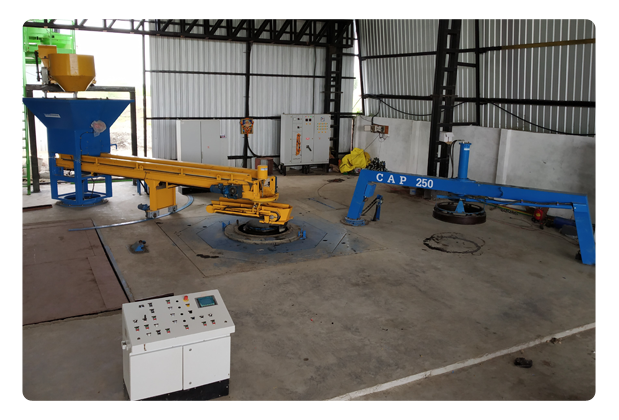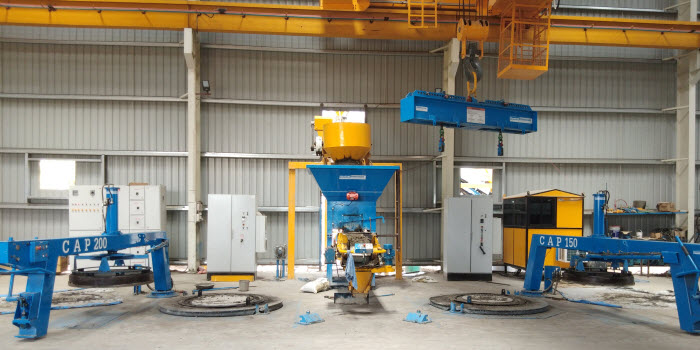
The concrete pipe industry has seen major advancements in technology. Modern concrete pipe machinery now integrates automation, vibration control and precision engineering to enhance production efficiency. The latest concrete pipe making machines are faster, more reliable and produce high-quality pipes with minimal waste.
For manufacturers in India, selecting the right concrete pipe making machine is crucial. Features like frequency-controlled vibration, hydraulic pressing and PLC automation have transformed production lines. These innovations help manufacturers reduce costs, increase output and ensure consistent product quality.
This article explores the key advancements in concrete pipe making machine manufacturers, their benefits and how automation is shaping the future of the industry.
The Role of Frequency-Controlled Vibration Speed in Concrete Pipe Manufacturing
Vibration technology plays a critical role in the concrete pipe making process. The latest machines use frequency-controlled vibration speed to improve compaction and consistency.
Key Benefits:
- Better compaction ensures a dense, durable concrete structure.
- Adjustable vibration speeds allow flexibility for different pipe sizes.
- Reduces air pockets, preventing weak spots in the pipe wall.
Modern concrete pipe making plants use this advanced vibration control to manufacture reinforced and non-reinforced pipes with high structural integrity.
Advantages of Radial Horizontal Feeder with Rotating Chute in Concrete Pipe Machine
Concrete feeding is a crucial step in pipe production. A radial horizontal feeder with a rotating chute improves material distribution inside the mold.
Why It Matters?
- Even concrete distribution reduces variations in pipe thickness.
- Rotating chutes prevent segregation of concrete ingredients.
- Faster filling process, increasing overall production speed.
By integrating this system, concrete pipe making machine ensure that every batch meets uniform quality standards.

Hydraulic Pressing and Rocking Function: A Key to Durable Concrete Pipe Production
The hydraulic pressing and rocking function in modern concrete pipe machines enhance the pipe’s load-bearing capacity.
Benefits of Hydraulic Pressing:
- Applies uniform pressure, reducing defects in the pipe body.
- Ensures tight compaction, extending the lifespan of the pipe.
- Eliminates weak spots, making pipes resistant to cracking.
This function is particularly useful in large concrete pipe making machines that produce heavy-duty pipes for infrastructure projects.
Why Demoulding with Overhead Crane is Essential in CAP 150/200 Concrete Pipe Machine?
Demoulding is a critical stage in concrete pipe production. Using an overhead crane for demoulding enhances efficiency and reduces damage to freshly cast pipes.
Key Benefits:
- Minimizes manual handling, reducing labor fatigue.
- Prevents pipe distortion during removal.
- Increases production speed, allowing faster cycle times.
Concrete pipe making machine manufacturers integrate this feature to improve safety and ensure consistent pipe quality.
The Impact of Powered Pivot for Press Arm and Concrete Feeder on Production Efficiency
The powered pivot for the press arm and concrete feeder is another innovation that improves automation in concrete pipe making machines.
How It Boosts Efficiency?
- Reduces manual adjustments, speeding up production.
- Ensures accurate press positioning, improving uniformity.
- Optimizes material flow, preventing waste.
This feature is especially beneficial in high-volume concrete pipe making plants, where precision and speed are essential.
How PLC Control System with Digital Display Enhances Precision in Concrete Pipe Manufacturing?
Automation has revolutionized the concrete pipe manufacturing industry. The PLC control system with a digital display ensures accurate production control.
Advantages of PLC Systems:
- Real-time monitoring of vibration, pressing and material flow.
- Digital adjustments for different pipe sizes and thicknesses.
- Reduces human error, ensuring consistent quality.
This automation reduces downtime and allows manufacturers to produce high-quality pipes with minimal variation.
Standard Features of CAP 150/200 Concrete Pipe Machine That Boost Productivity
The CAP 150/200 series is a leading concrete pipe machine known for its efficiency and reliability.
Key Features:
- Synchronized core vibration for high-strength pipes.
- Radial horizontal feeder with rotating chute for even material distribution.
- Hydraulic pressing and rocking function for superior compaction.
- Overhead crane demoulding system for safe and efficient pipe removal.
- PLC-controlled automation for precise production control.
These features make the CAP 150/200 a top choice among concrete pipe making machine worldwide.
The Significance of Synchronized Core Vibration for High-Quality Concrete Pipes
Synchronized core vibration ensures that each pipe produced has uniform density and durability.
How It Improves Concrete Pipe Quality?
- Eliminates air voids, reducing structural weaknesses.
- Enhances load-bearing capacity, making pipes suitable for heavy-duty applications.
- Optimizes material use, minimizing waste and production costs.
This technology is now standard in large concrete pipe making machines, offering improved performance and efficiency.
How Automation in Concrete Pipe Machine Reduces Production Time and Cost?
Automation is reshaping the concrete pipe production by increasing speed and reducing manual labor.
Major Benefits of Automation:
- Faster production cycles, increasing output.
- Lower labor costs, as machines handle most of the workload.
- Consistent product quality, reducing rework and defects.
Modern concrete pipe making plants are now designed for fully automated operations, ensuring high precision and cost efficiency.
Conclusion
Advancements in concrete pipe machinery have transformed manufacturing processes. From frequency-controlled vibration to PLC automation, modern concrete pipe making machines offer superior efficiency, quality and cost savings.
For businesses looking to invest in concrete pipe making machine India, choosing the right features - such as hydraulic pressing, overhead crane demoulding and automated feeders - ensures long-term success. The future of concrete pipe making plants lies in automation, precision and innovation.
FAQs - Stone Elevators and Screening Systems
The concrete pipe making machine price varies based on size, automation and capacity. Advanced models with automation cost more but offer higher efficiency.
It ensures even compaction, reducing weak spots and increasing pipe durability.
It prevents damage during demoulding and speeds up production by reducing manual handling.
They provide real-time monitoring, reduce errors and allow digital adjustments for precision manufacturing.
Key features include synchronized core vibration, hydraulic pressing, PLC automation and overhead crane demoulding for efficient operation.
Read More Articles on Concrete Pipe Machinery
- Application of Concrete Pipe Machine in Construction of Drainage Systems
- Emerging Markets for Concrete Pipe Machines in Different Continents
- The Features and Benefits of a Concrete Pipe Machine
- Boosting Productivity with Dual Station Capability in Concrete Pipe Machines
Recent Articles
- How Drycast Technology is Changing the Concrete Pipe Industry?
- Common Mistakes to Avoid When Selecting Pipe Moulds for Your Machine
- How to Match Your Concrete Pipe Making Machine with the Perfect Drycast Mould?
- How to Keep Concrete Pipe Machine and Drycast Moulds in Top Condition? Maintenance Guide
- Box Pallets & U-Drain Pallets: Essential Components in Modern Drainage Systems





 BACK TO ARTICLES
BACK TO ARTICLES